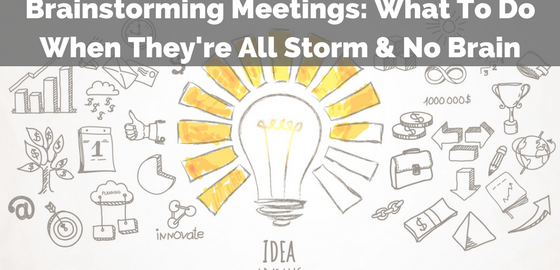Remember when brainstorming meetings were cool?
The problem with getting together with your cohorts and coercing the creative juices to flow is that creativity doesn’t work like that; it’s not tied to deadlines. Nor does creativity care that such-and-such is due today.
So the next time your boss calls a 3-hour brainstorming meeting, send a link to this post and try these ideas instead.
Old-School Brainstorming Meetings
I feel like we marketing peeps get especially squirmy when someone recommends brainstorming meetings.
I’m guilty of this, too! Coming together to share ideas isn’t stupid, it’s just that everyone’s creative juices happen differently … at different times, in unconventional ways, and in different places.
I prefer the shower. Or a long car ride with music blaring. Those really aren’t conducive to having my team members join me, you know?
Besides, during traditional brainstorming meetings, extroverts are blurting out any idea that pops into their head while the introverts are silently praying it’s going to be over soon.
“Please don’t call on me. Please don’t call on me. Please don’t call on me!”
And then there’s Groupthink — every entrepreneur, leader, or manager’s nightmare.
I see groupthink rear its ugly head in our Level 10 Meetings sometimes and it makes me get all panic-y.
No one wants to lead their team to make biased, premature, or just plain BAD decisions.
This is why you need to consider something other than brainstorming meetings to get better results.
4 New-School Brainstorming Methods
1) The S.C.A.M.P.E.R. Method — Elicit the next project iteration by looking at the project from different perspectives or angles.
- Substitution: What would happen to the project if we swapped X for Y?
- Combination: What would happen to the project if we combined X and Y?
- Adaptation: What changes would need to be made to adapt this project to a different context?
- Modification: What could we modify to create more value for this project?
- Put to another use: What other uses or applications might this project have?
- Elimination: What could we remove from the project to simplify it?
- Reverse-engineering: How could we reorganize this project to make it more effective?
2) The Brainswarming Method — Cognitive psychologist Dr. Tony McCaffrey said about brainstorming,
” … doesn’t work because sharing ideas one at a time, by talking no less, is incredibly inefficient.”
Watch the video below for specifics on this method.
3) The Brainwriting Method — A “write first, talk second” method; idea generation should exist separate from the discussion created by Leigh Thompson and Loran Nordgren, management professors at the Kellogg School.
Thompson’s studies found that compared to traditional brainstorming meetings, brainwriting
- Generates 20% more ideas
- Produces 42% more original ideas
They even created a free app called Candor that you can use to implement this method!
4) Six Thinking Hats Method — Derived in 1985 from Edward de Bono’s book; wherein parallel thinking provides a means for groups to plan their thinking processes in a detailed and cohesive way, and in doing so to think together more effectively.
HubSpot created the perfect graphic representation of Six Thinking Hats:

Other Ideas
There’s a reason my best ideas happen while showering or on the road.
Our brain waves occur in four states depending on our level of activity:
- Beta: When we are consciously alert; includes feelings of being agitated, tense, or afraid (most active state).
- Alpha: A state of physical and mental relaxation, although we are aware of what is happening around us.
- Theta: The state of sleep/drowsiness with reduced consciousness.
- Delta: Unconsciousness, deep sleep or catalepsy.
Educator Ned Herrmann explains why theta is good for brainstorming,
“Individuals who do a lot of freeway driving often get good ideas during those periods when they are in theta . . . This can also occur in the shower or tub or even while shaving or brushing your hair. It is a state where tasks become so automatic that you can mentally disengage from them. The ideation that can take place during the theta state is often free flow and occurs without censorship or guilt.”
So, it may sound silly but …
- Go for a drive
- Draw a bubble bath
- Go for a walk
Take notes as you go along (or dictate them to Siri while driving — be safe!) and review them later with your team using one or more of the methods above.
Brainstorming meetings may not bear the best results, but that doesn’t mean you aren’t getting feedback from others on ideas.
What Are Your Brainstorming Tricks?
How do you do your best brainstorming? Do brainstorming meetings still take place where you work?
Let us know your tips and tricks in the comments section below!
Business & Finance Articles on Business 2 Community(118)









